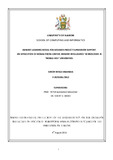| dc.description.abstract | Although there is high penetration of mobile phones among students in East African universities (‘mobile-rich’), there is a certain category of students, such as research students, that do not own a personal computer (‘computer-poor’). Such students are forced to move to fixed locations where they access internet connected computers for accessing electronic learning (E-Learning) content. This location dependent access to learning resources removes the flexibility that is needed in personalized learning.
As an attempt to address these limitations, we proposed a new ambient learning approach known as Open Ambient Learning (OMAL). The approach uses Mobile phone-centric Ambient Intelligent (M-AMI) technologies to integrate three concepts. First, mobile interface ambient learning utilizes mobile devices only to support learning. Second, cloud computing services refer to computing services that are provided over the internet. Thirdly, Open Education Resources (OER) refers to freely accessible learning resources. The approach aims at allowing flexible availability of supervisors to their research students that are in 'mobile-rich' but 'computer-poor ' learning settings, like the case in East African universities.
To achieve this objective, communication oriented design research methodology (CODSRM) was used to guide the study. The methodology had two main stages. First, development stage that entailed conducting a research survey, case based research and adopting creative process to design and develop OMAL model. During the survey research activity, both stratified purposive sampling and random sampling were used for selecting respondents whilst during the case based research activity, only purposive sampling was used to select target publications. Second, the evaluation stage that involved conducting an experimental design study to assess the flexible availability of research study materials afforded by OMAL model.
Pre-experiment results showed that more than 90% of the students in Kenyan universities own mobile phones but only about 16% of them use mobile applications to access research study materials. Post-experiment results indicated that, all the developed M-Learning approaches significantly increased flexible availability of research study materials and the highest margin was registered within the OMAL approach. Based on these results, we conclude that mobile phone-centric ambient intelligence technologies can be used to integrate ambient learning with open education resources and cloud computing services to enhance flexible availability of learning resources in the student project supervision process. | en_US |



